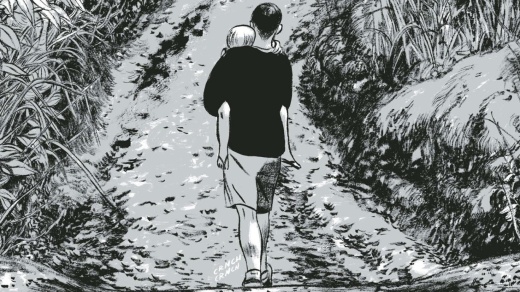The hype in ‘Hype’rion is real. This book is awesome.
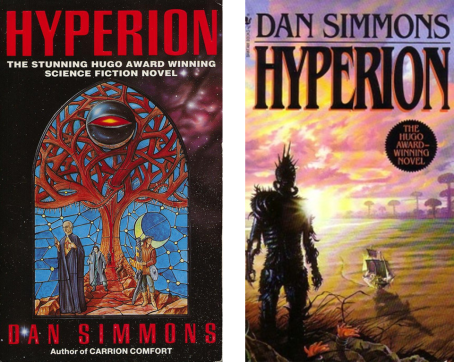 Entering this story was like entering a chat room full of veterans, as a total noob. There were no expositions, no introductions, no explanations on the world order for a highly allegorical story filled with passing references to things unknown. Yet, by the end of the book, I found myself transformed from “What is a Shrike?” to “What the Shrike!”
Entering this story was like entering a chat room full of veterans, as a total noob. There were no expositions, no introductions, no explanations on the world order for a highly allegorical story filled with passing references to things unknown. Yet, by the end of the book, I found myself transformed from “What is a Shrike?” to “What the Shrike!”
The background is set in a distant future where humanity has spread across the galaxy under a decadent society aptly named as Hegemony of Man. Hegemony often finds itself in conflict with the original inhabitants and ‘intergalactic Ronins’ called Ousters, in their coercive efforts for incorporating every planet to their farcasted WorldWeb. Almost all of mankind’s technologies are controlled by an agglomeration of AIs known as TechnoCore, which also predicts future by extrapolating events from past and present, like Psychohistory in Foundation. The Ousters and Technocore, for half explained reasons, are obsessed with strange structures called Time Tombs in the distant planet of Hyperion. Time Tombs are surrounded by an anti-entropy field and are said to be under the protection of a legendary time traveling creature called Shrike. Seven selected individuals are sent on a pilgrimage to time tombs by TechnoCore for aiding Hegemony in imminent war for annexation of Hyperion to WorldWeb. If I may do a frail comparison with The Expanse, Hegemony is UN, Ousters are OPA, Pilgrims are crew of Rocinante and Shrike is the protomolecule in a macro scale.

Hyperion is also the name of an abandoned epic poem by 19th century Romaticist John Keats, and this novel draws huge parallelism with Keats‘ life and works. Along with that, the novel also expects readers to be familiar with Norse terminology, Biblical stories and many other things that I had no first-hand knowledge of. And further, the narrative treats readers like they are already familiar with the surroundings as much as any other Pilgrim is. But a well-conceived story line with fine prose, fascinating characters with well-developed stakes make the reading highly enjoyable even without any of above predispositions. Also I found the multiple pov unraveling of the universe more enjoyable than the usual biased view through the perception of a single character.
‘In Medias res’ is the literary practice of opening narrative amidst action; it enables the author to bypass superfluous expositions through variegated time lines and dialogues. Most of Hyperion’s story or story telling happens in a physical space by that name, where Simmons takes us through the intricate details of universe through character flashbacks. Rather fitting, I would say. Each Pilgrim story can be considered as a standalone book, and this seemingly fix-up structure with inside epistolary stories feels somehow supple even with main narrative’s expansive nature. Usual tendency among interconnected stories is to weave characters and events with each other through different vantage points; but here the stories more like separate novellas sharing same universe as those of Culture or Revelation Space. In a weird way, whole exercise reminded me of LOST.
Simmons has been offering theological, historical and literature allegories throughout the stories; often provoking our thought in its powerful narrative. Hyperion, Time Tombs and Shrike are a mystery for every faction in the universe to which everyone is somehow connected. Whole pilgrimage and Hyperion seemed to me like an allegory for purgatory and redemption. Each character has got his/her personal interpretation of Shrike and their own personal artefacts; like God being a different concept for each individual and faith being as personal as it can get.
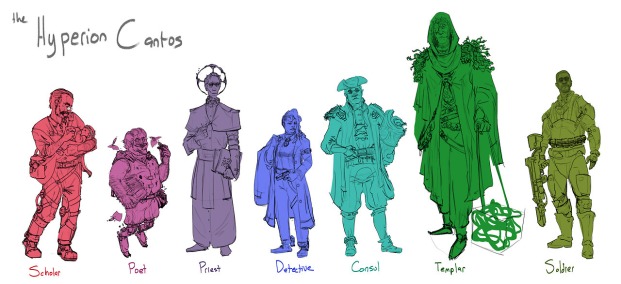
In Priest’s tale, Fr. Dure was modelled after historical figure of Pierre Teilhard de Chardin, the celebrated Jesuit palaeontologist who was exiled by Church for allegedly fabricating archaeological evidences of Piltdown Men. Bikura tribe, Tesla Tree and Cruciform were direct allegories towards the philosophy of afterlife and resurrection in Christian theology. I found it amazing and terrifying at the same time, along with story’s subtle critique on blind beliefs. Kassad’s space opera was spoiler filled and a bit timey-wimey like that of the Doctor and River Song, and was perhaps the weirdest among this weird lot. Third story involving the Poet Martin Silenus felt like a loose adaptation of Keats life, which could be tagged as paraphrased slash fiction. Sol and the ‘curious case of his daughter’ Rachel was the most compelling and emotional story for me. For Sol, Hyperion was the Moria Mountain for his personal binding of Isaac. Brawne Lamia’s (Lamia is the name of a poem by Keats) hard boiled cyberpunk detective story had the central plot of Altered Carbon up its sleeve as far as I was concerned. By the final story involving Consol and consequences of time debt in Interstellar travel; the universe has been wrapped up pretty nicely, though an excessive usage of Planet of Hats trope was hard to be ignored.
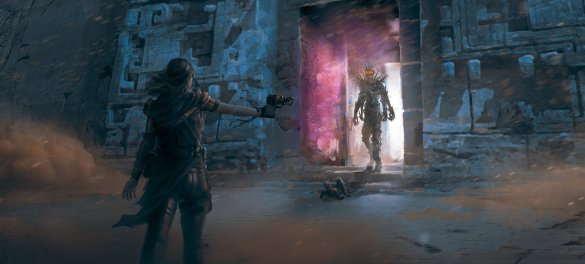
After planet fall their ship Yggdrasil(the Nordic tree of universe) is said to have been destroyed by Ouster attack, and I couldn’t help but connect the burning of cosmic tree with end of the world, Ragnarok; thanks to Marvel. Time tombs and mystery of Shrike felt like a Skynet plot even from the interpretations of Ousters or AI. Also Simmons has done a commendable job in establishing the technological asymmetries between colonies and the Hegemony via farscaping and Hawkings Drive. I absolutely adored his attention to detail towards ways of old earth that tends to pop up now and then with romantic reverence, whether it is the usage of carpets or mythology or nomenclature of old technologies with archaic terms, like Benares for the Barge. Things were mostly explained as status quo and left to be picked up in the reading process. For example, Silenus house having real time windows to different planets had left me perplexed during Poet’s story, only to have it later explained by Siri (yes, Siri) as farscaster portals in Lamia’s story. I loved this style of writing and it left me like a teen who just got treated like an adult like he always wanted to have.
I would totally understand the criticisms against this novel though I have a strong leaning towards book that invests on plots over characters. The whole thing feels like an extended prologue or pilot episode; And the abrupt ending does kind of feel unconventional, like you have watched only the first half of movie Inception or MCU coming to a halt just before the first Avengers movie. If one has been waiting for a Then There Were None style big reveal at the end, or some clear explanations about the eeriness behind Shrike, the disappointment is all the more justifiable. But the whole thing worked for me, like the story being a book example for all those coffee mugs quotes and self-discovery movies that venerate journey over destination. I was rather blown away by the sheer scale of things, ensemble of genres, nonlinear narrative structure and the massive word and world building. And to me, the ending was ingratiating; maybe not in a comprehensive sense, but rather like a noob who has discovered his knack in a new game.
Keats never finished his poem, and Simmons leaving the first book in Hyperion quartet unfinished is strangely fitting, considering his fixation on the Poet. If it’s any consolation, I found The Fall of Hyperion quite satisfying and equally awesome, if you are up for the effort.

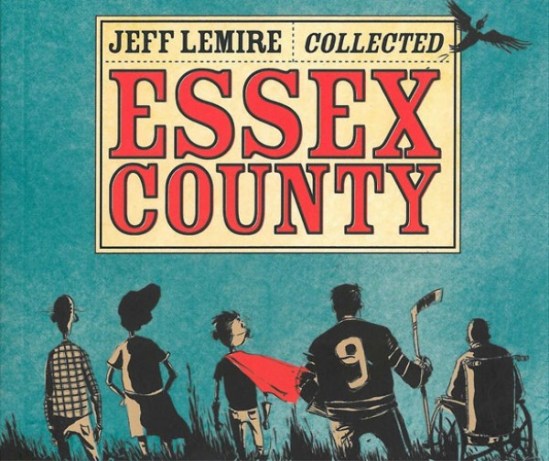 With Jeff Lemire’s name and this bright artwork on cover, I was expecting something heartwarming. It was warm, in fact a bit too warm that my heart got melted away.
With Jeff Lemire’s name and this bright artwork on cover, I was expecting something heartwarming. It was warm, in fact a bit too warm that my heart got melted away. I found a lot of my confused childhood in ‘Lesters’ eyes, the awkwardness and loneliness and escapism in comic book reality. Even in the absence of colours and detailing, little incoherent circles that formed his eyes, and single line that formed his facial expression, conveyed a lot to me than usual words would. Like brightening of the circles and downward curving of lines, when ‘Lester’ was running around in the farm, in his red cape.
I found a lot of my confused childhood in ‘Lesters’ eyes, the awkwardness and loneliness and escapism in comic book reality. Even in the absence of colours and detailing, little incoherent circles that formed his eyes, and single line that formed his facial expression, conveyed a lot to me than usual words would. Like brightening of the circles and downward curving of lines, when ‘Lester’ was running around in the farm, in his red cape.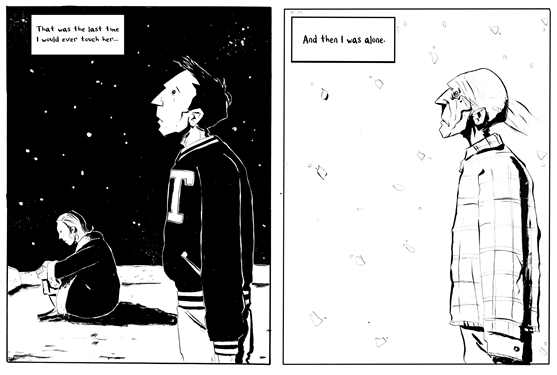 The second story was too intense for me, it hit me so hard in my feels that I had to close the book more than a few times. Though it is a singular story line, the sequence is jarred, and we are switched through povs and timelines, almost effortlessly. As depressing as it sounds, I somehow identified myself the most with ‘Lou’ in his loneliness, nonchalance and melancholy. Jeff was honest in his literature and artistic depiction of guilt and loss, and their aftermath. There was a lot of similarity between Lester and Lou, mostly on the pleasant side, and for more than once in the surreal business of flashbacks I suspected the latter being the elder version of former. The simultaneous loss of love and friendship drives Lou to strong guilt, the kind that doesn’t allow you to move on or be happy. He tries to make sense of my his lonely life by holding on to the only thing that matters- Hockey, to which he was a one hit wonder of; yet his life somehow finds its way back to the focal point of tragedy.
The second story was too intense for me, it hit me so hard in my feels that I had to close the book more than a few times. Though it is a singular story line, the sequence is jarred, and we are switched through povs and timelines, almost effortlessly. As depressing as it sounds, I somehow identified myself the most with ‘Lou’ in his loneliness, nonchalance and melancholy. Jeff was honest in his literature and artistic depiction of guilt and loss, and their aftermath. There was a lot of similarity between Lester and Lou, mostly on the pleasant side, and for more than once in the surreal business of flashbacks I suspected the latter being the elder version of former. The simultaneous loss of love and friendship drives Lou to strong guilt, the kind that doesn’t allow you to move on or be happy. He tries to make sense of my his lonely life by holding on to the only thing that matters- Hockey, to which he was a one hit wonder of; yet his life somehow finds its way back to the focal point of tragedy.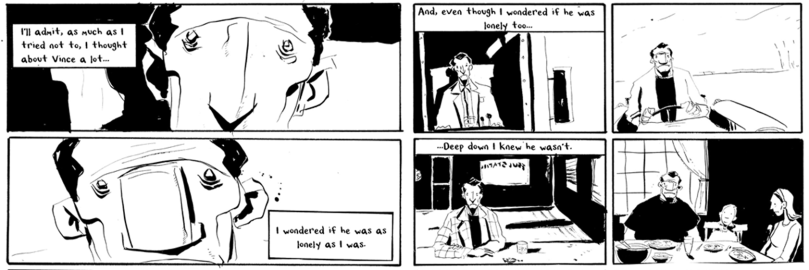 The subtle difference between grief and guilt was addressed in surprising detail here, like how others move on with their life and you are left with a perpetrator guilt that runs simulations of ‘what if’ scenarios in your head over and over. And even after eons, the first thing that gets to your head about a broken friendship would be that focal point. You will be looking for excuses, trying to fix something that is permanently broken and that no one anymore cares about. Guilt keept Lou in a state of perpetual ‘Merlin Sickness’; shrinking him mentally towards the traumatic past, and physically away from it.
The subtle difference between grief and guilt was addressed in surprising detail here, like how others move on with their life and you are left with a perpetrator guilt that runs simulations of ‘what if’ scenarios in your head over and over. And even after eons, the first thing that gets to your head about a broken friendship would be that focal point. You will be looking for excuses, trying to fix something that is permanently broken and that no one anymore cares about. Guilt keept Lou in a state of perpetual ‘Merlin Sickness’; shrinking him mentally towards the traumatic past, and physically away from it.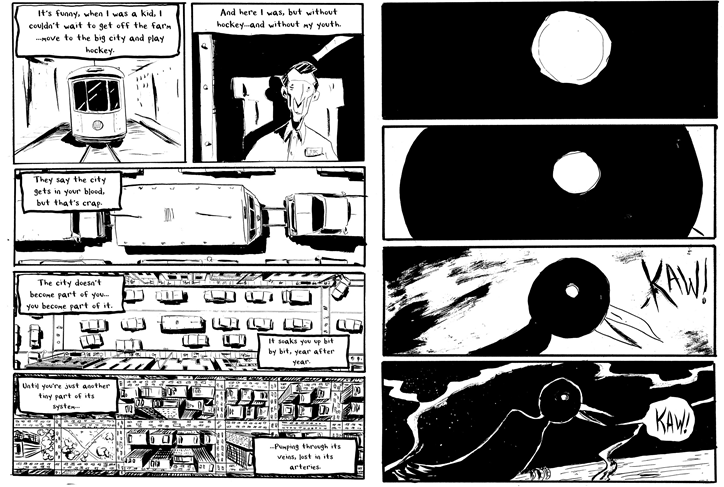 The last story, involving the Nurse was the one I connected least with even though it was the most communicative among the three. Yet, in a way, it was the story line I needed most. The whole book is predictable, occasionally surreal and even melancholic. But there is an element of magical realism in it, an unreliability in the narration that bends reality between characters, time zones, dreams and memories. There are moments that make you smile, moments that make you ponder even if it’s something as insignificant as the appearance of a crow, and moments that make you sad, but fills you with hope. Jeff does a great job in making characters as real as possible, they age, they feel and they respond like a normal human being than someone sketched out on a paper. And above all, it is beautiful.
The last story, involving the Nurse was the one I connected least with even though it was the most communicative among the three. Yet, in a way, it was the story line I needed most. The whole book is predictable, occasionally surreal and even melancholic. But there is an element of magical realism in it, an unreliability in the narration that bends reality between characters, time zones, dreams and memories. There are moments that make you smile, moments that make you ponder even if it’s something as insignificant as the appearance of a crow, and moments that make you sad, but fills you with hope. Jeff does a great job in making characters as real as possible, they age, they feel and they respond like a normal human being than someone sketched out on a paper. And above all, it is beautiful.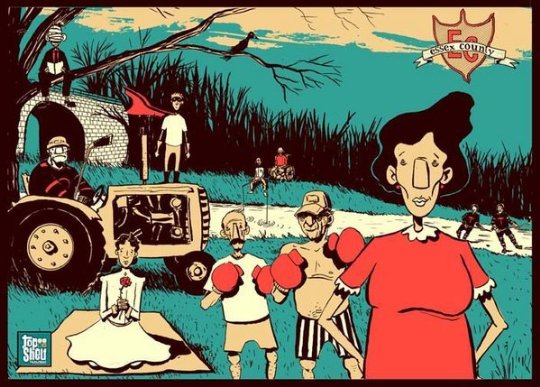 As I was nearing the end of my reading, the book had left me devastated, badly in need for a hug. And surprisingly, by the time it all ended, the book itself became the very hug that I badly needed.
As I was nearing the end of my reading, the book had left me devastated, badly in need for a hug. And surprisingly, by the time it all ended, the book itself became the very hug that I badly needed.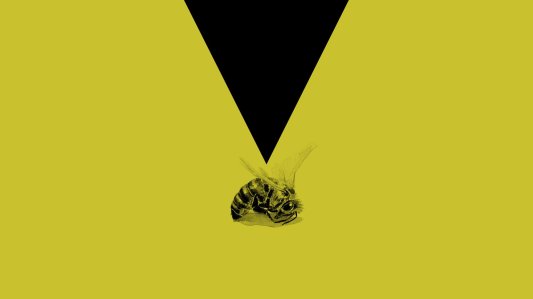






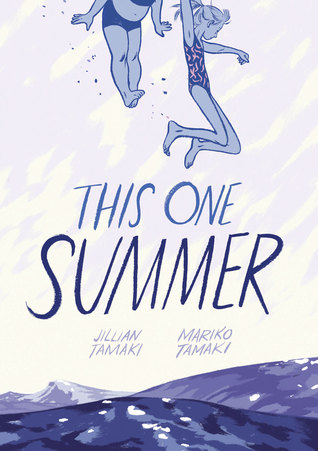 This beautiful graphic novel is a slice of life in its literal sense; the whole thing seems to have been sliced off from a bigger plot. Artwork is dream like, its overall cheerful, monochromatic and yet somehow very colourful.
This beautiful graphic novel is a slice of life in its literal sense; the whole thing seems to have been sliced off from a bigger plot. Artwork is dream like, its overall cheerful, monochromatic and yet somehow very colourful.